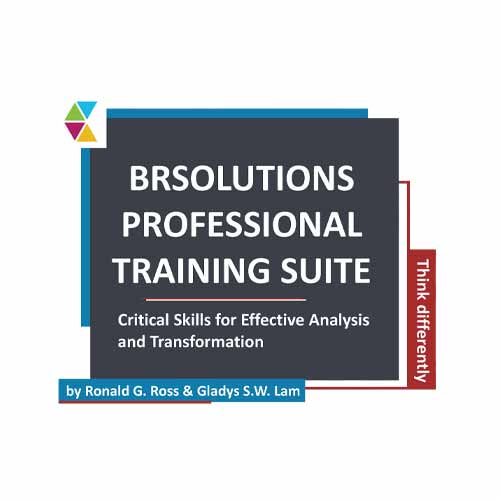Shiny Objects & the Cult of Complexity
The development of organizational management theory should seek to make operational management simpler, not more complex. Is it possible that the primary goal of organizational performance improvement gets lost in the ever-increasing list of shiny objects such as transformation, digitalization, robotization, valuation, acceleration, innovation, automation, and disruption? Are the -ion ideas a distraction or a boon for good management?
"Perfection is achieved, not when there is nothing more to add, but when there is nothing left to take away."
Antoine de Saint-Exupéry[1]
As a process practitioner, an important part of my job is to help make management simpler. Not more complex, simpler. Surely this is also true of fellow travelers in the many forms of architecture, in business rules, in business analysis, and in all the dark arts of management? Management will never be simple — any undertaking involving people is bound to get complicated — but there are ways to make it simpler to understand, design, and execute. There are also many ways to make it more complicated than it needs to be.
We need ways to get to the core of organizational management, to clear away the mists and distractions and get focused on what really matters. Creating the world's most complex PowerPoint slide, or crafting the most abstract set of words, doesn't help. Conjuring up increasingly-complicated methods is more likely to hide than reveal core truths. Our objective must be to illuminate, not to confuse.
In their opening keynote at the recent BPM Conference in London (produced by IRM UK), Roger Burlton and Chris Potts led a valuable discussion amongst delegates about the important conference themes: transformation, digitalization, valuation, and innovation. For completeness, we can add a few other common -ion words to this list: automation, disruption, agilization, robotization, acceleration (at least one of which I may have just made up!).
There was lots of useful discussion at the conference, as there is in many organizational settings, about the meaning of those ideas, their interrelationships, and their relative merits and importance. Which is more important and meaningful? Can they be combined?
One key theme that comes from such discussions is how to sell ideas to the C-suite, how to get executive commitment to, and funding for, another important -ion word, execution.
It often feels like the purpose of the ever-increasing list of such buzz words — shiny objects — is to catch the attention of executives, to exercise a cargo-cult mentality where if we create a <insert shiny adjective here> program, wonderful things will happen.
Does the C-suite really need shiny objects? Do they really depend on management-by-slogan? I hope not — they are running a world of organizations, and we are rather dependent on them. We need them to be making rational, logical choices and not be swayed by the latest word du jour.
What the words and ideas in this -ion collection have in common, and surely their shared purpose, is to improve the performance of organizations, to improve the way in which organizations execute their strategic intent. Management is about the execution of strategy and the measurable, objective, and continuous improvement of organizational performance.
We are in danger of creating a vicious cycle of increasingly-complex ideas that require additional increasingly-complex ideas to describe them; it's complex ideas all the way down!
Improvement of organizational performance may involve accelerated transformation — through innovative disruption and the use of digital, robotic, automated solutions — leading to improved valuation and more agile execution! However, the result, the ultimate goal, must be improved organizational performance. All else is a means to that end.
For those of you who have been following my writing (thank you), you know what's coming next — this is a business process performance issue. My guiding management principle, the primacy of process, says that the only way any organization can create, accumulate, and deliver value (products and services) outside the organization is via cross-functional business processes, and that those processes are, therefore, also the way that every organization executes its strategic intent.
There are many things we do to improve the performance of processes; the -ion ideas are commonly and importantly part of that set. Before we start on any of them, we must discover and document the process hierarchy, understand how the processes should perform and are performing, and create a mechanism for making cross-functional changes (since the organization chart says little about cross-functional management). This frames the elegant simplicity required for effective and sustained improvement of organizational performance.
Once we know what processes we are trying to improve, what that improvement would look like (in solid business/organizational terms), and how cross-functional change will be achieved and sustained, then we can invoke as many of the -ion ideas as we like.
What will then follow is illumination, not from shiny objects but from the removal of concealing complexity.References
# # #
About our Contributor:
Online Interactive Training Series
In response to a great many requests, Business Rule Solutions now offers at-a-distance learning options. No travel, no backlogs, no hassles. Same great instructors, but with schedules, content and pricing designed to meet the special needs of busy professionals.











How to Define Business Terms in Plain English: A Primer
How to Use DecisionSpeak™ and Question Charts (Q-Charts™)
Decision Tables - A Primer: How to Use TableSpeak™
Tabulation of Lists in RuleSpeak®: A Primer - Using "The Following" Clause
Business Agility Manifesto
Business Rules Manifesto
Business Motivation Model
Decision Vocabulary
[Download]
[Download]
Semantics of Business Vocabulary and Business Rules